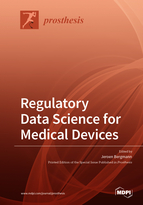Regulatory Data Science for Medical Devices
A special issue of Prosthesis (ISSN 2673-1592).
Deadline for manuscript submissions: closed (30 August 2021) | Viewed by 24546
Special Issue Editor
Special Issue Information
Dear Colleagues,
This Special Issue covers works that will be presented during the Oxford Regulatory Science Conference 2021 (ORSC21). Please visit www.in-li.org for more information on the conference.
Quantitative science for medical device regulations is an emerging field. The research focuses on applying quantitative methods to create new evidence, tools, methods/algorithms, guidance, quality management, and standards, with the purpose to progress the evaluation of medical technologies. The aim is to improve the safety, quality, efficacy, and performance of medical devices by providing cutting-edge quantitative science that can inform policies and processes. The impact of regulatory science is shown in the critical function that regulations play in bringing new technologies to market. The ability to place and keep relevant technologies on the market is essential for patient impact. Quantitative regulatory science can also assist regulatory bodies, by informing them about new evidence on process, guidance, or standards for technologies. Research can facilitate more transparent regulatory decision making for novel medical technologies and highlight problems that should be addressed. This journal will also cover regulatory research related to software as medical devices, including studies related to machine learning and artificial intelligence for medical use. The science in this area can be leveraged to aid harmonisation of global medical device regulations. Interdisciplinary research in this domain will create large-scale economic, social, and clinical impact. In the digital era, we believe that data-driven insights will be imperative to furthering the work currently being conducted within regulations for medical technology, and this journal will provide great value to all the regulatory stakeholders.
Prof. Dr. Jeroen Bergmann
Guest Editor
Manuscript Submission Information
Manuscripts should be submitted online at www.mdpi.com by registering and logging in to this website. Once you are registered, click here to go to the submission form. Manuscripts can be submitted until the deadline. All submissions that pass pre-check are peer-reviewed. Accepted papers will be published continuously in the journal (as soon as accepted) and will be listed together on the special issue website. Research articles, review articles as well as short communications are invited. For planned papers, a title and short abstract (about 100 words) can be sent to the Editorial Office for announcement on this website.
Submitted manuscripts should not have been published previously, nor be under consideration for publication elsewhere (except conference proceedings papers). All manuscripts are thoroughly refereed through a single-blind peer-review process. A guide for authors and other relevant information for submission of manuscripts is available on the Instructions for Authors page. Prosthesis is an international peer-reviewed open access semimonthly journal published by MDPI.
Please visit the Instructions for Authors page before submitting a manuscript. The Article Processing Charge (APC) for publication in this open access journal is 1600 CHF (Swiss Francs). Submitted papers should be well formatted and use good English. Authors may use MDPI's English editing service prior to publication or during author revisions.
Keywords
- medical device regulation
- medical technology
- data science
- patient safety
- medical software






